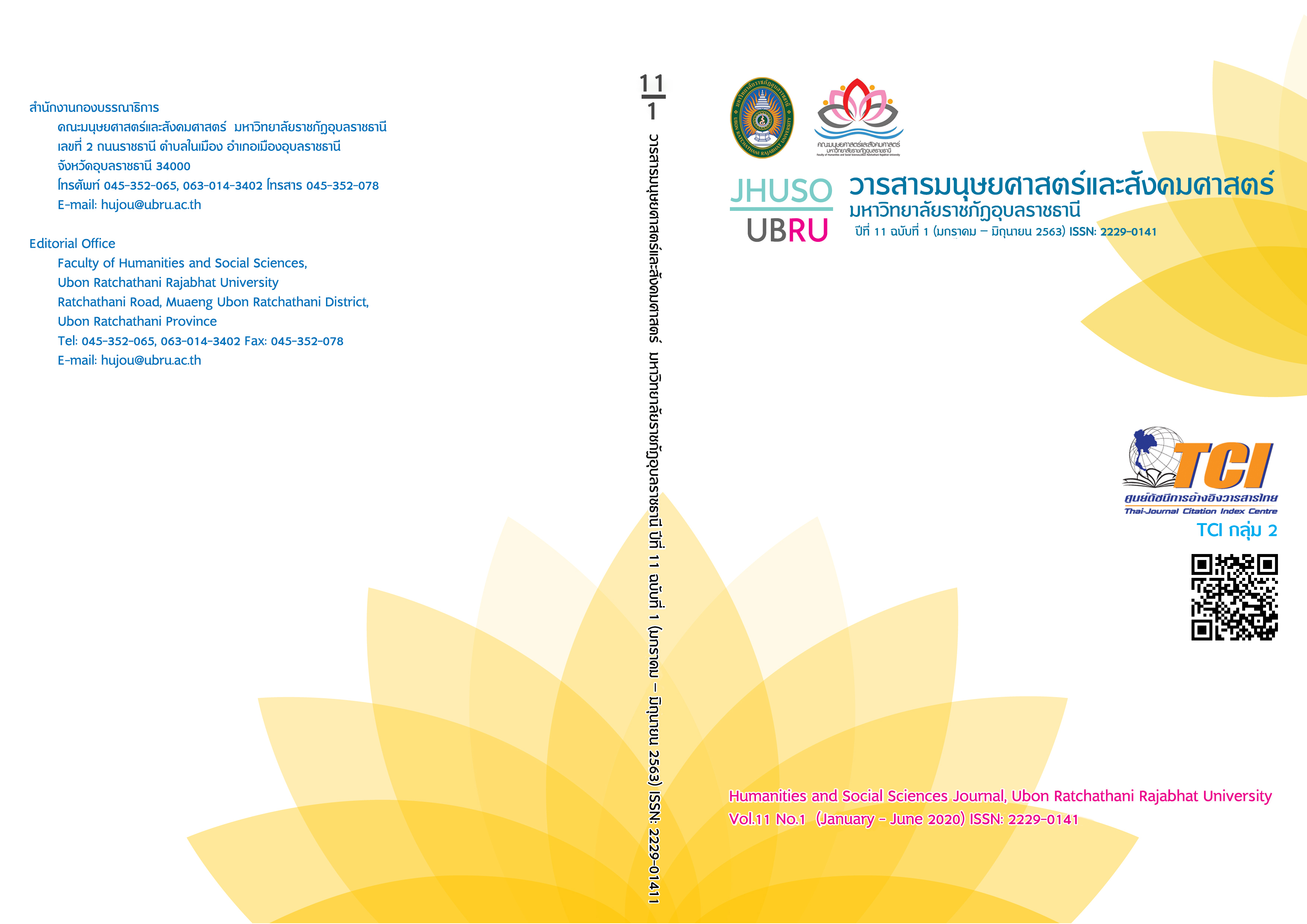Washback Effect of Direct TOEIC Preparation Class on Students’ Motivation
Main Article Content
บทคัดย่อ
งานวิจัยนี้มีจุดประสงค์เพื่อ 1) สำรวจผลกระทบของการเรียนเพื่อการเตรียมสอบโทอิคที่มีต่อแรงจูงใจของนักศึกษา และ 2) เปรียบเทียบแรงจูงใจของนักศึกษาที่มีผลคะแนนต่างกัน กลุ่มตัวอย่างประกอบด้วยนักศึกษาชั้นปีที่ 3 สาขาวิชาภาษาอังกฤษธุรกิจ จำนวน 37 คนที่ได้ลงทะเบียนเรียนในรายวิชา การเตรียมสอบโทอิค ในภาคการศึกษาที่ 2 ปีการศึกษา 2561 เครื่องมือที่ใช้ในการเก็บข้อมูลคือ แบบสอบถาม และวิเคราะห์ข้อมูลโดยใช้ ร้อยละ ค่าเฉลี่ย และค่าเบี่ยงแบนมาตรฐาน ผลการวิจัยพบว่า การเรียนเพื่อการเตรียมสอบโทอิคมีผลต่อแรงจูงใจของนักศึกษาเนื่องจากคะแนนโทอิคมีประโยชน์ต่อการทำงานในอนาคต (4.78) ในส่วนของการเปรียบเทียบแรงจูงใจของนักศึกษาที่มีผลคะแนนต่างกันนั้น ทั้งกลุ่มนักศึกษาที่มีคะแนนสูง (4.91) และกลุ่มนักศึกษาที่มีคะแนนต่ำ (4.72) เห็นตรงกันว่า การที่ได้คะแนนโทอิคสูงนั้นมีความสำคัญต่ออาชีพในอนาคต นอกจากนี้ นักศึกษาทั้ง 2 กลุ่มยังมีแรงจูงใจในการเรียนภาษาอังกฤษเพราะนักศึกษาคาดว่าจะได้ใช้ภาษาอังกฤษในการทำงานบ่อยครั้ง นักศึกษาที่มีคะแนนสูง (4.83) มีความเห็นว่าการเรียนเพื่อการเตรียมสอบโทอิคนั้นส่งผลให้ได้คะแนนโทอิคมากขึ้น แต่อย่างไรก็ตาม นักศึกษาทั้ง 2 กลุ่มไม่ได้รู้สึกว่าการเรียนเพื่อการเตรียมสอบโทอิคช่วยพัฒนาภาษาอังกฤษได้อย่างรวดเร็ว ดังนั้น ในการเตรียมความพร้อมเพื่อการสอบโทอิคของนักศึกษาจึงควรมีการส่งเสริมปรากฏการณ์วอชแบคเชิงบวก (Positive Washback)
Article Details
เอกสารอ้างอิง
Apichatrojanakul, P. (2011). The Washback Effects of the TOEIC Examination on the Teachers and Students of a Thai Business School. Language Testing in Asia, 1(1), 62-74.
Bachman, L & Palmer, A. (1996). Language testing in practice: Designing and Developing Useful Language Tests. Oxford: Oxford University Press.
Baker, E. (1991). Alternative Assessment and National Policy. Paper presented at the National Research Symposium on Limited English Proficient Students' Issues: Focus on Evaluation and Measurement, Washington, DC.
Brown, H. (2006). Learner Perceptions of TOEIC Test Results and Language Skill Improvements: “I don’t want to study English, I want to study TOEIC”. ResearchGate, 1176-1181.
Brown, H., D. (1994). Principles of Language Learning and Teaching. (3rd ed.). New Jersey: Prentice Hall Regents, Englewood Cliffs.
Educational Testing Service. (2016). TOEIC Listening and Reading Test Scores and the CEFR Levels. Retrieved from https://www.etsglobal.org/content/download/768/12037/version/8/file/TOEIC+L %26R+Descriptors-MAR089-LR.pdf. On January 16, 2019
____________. (2018). 2017 Report on Test Takers Worldwide. Retrieved from https://www.ets.org/s/toeic/pdf/2017-report-on-test-takers-worldwide.pdf. On January 16, 2019
Griggers, C. (2004). English Language Education Ensuring the Success of Thailand's Business Future. BOI Investment Review, 13(4), 3 - 4.
Hughes, A. (2003). Testing for Language Teachers. (2nd ed.). Cambridge: Cambridge University Press.
Lee, E. H. & Oh, H. J. (2011). Relationship between Motivation and Proficiency Improvement. Linguistic Research, 28(2), 405-430.
Liu, T. (2014). Washback Effects of the TOEIC Examination: A Study of Adult Learner’s
Attitudes toward English Exams, Learning and Teaching in a TOEIC Preparation Class. Retrieved from https://www.semanticscholar.org/paper/Washback-Effects-of-the-TOEIC-Examination%3A-A-study-%E5%8A%89%E5%AD%90%E7%91%9B-Liu/69d6d40ed3f5a09fccbb9ee327baf7da13dbfc08. On December 29, 2018.
Maliwan, S. (2018). TOEIC Preparation Course for Aviation Personnel Development Institute Students. Kasem Bundit Journal, 19(special edition): 234-243.
McNamara, T. (2000). Language Testing. Oxford: Oxford University Press.
Ministry of Education. (2017). Ministry of Education Announcement on Qualification Standard for Bachelor's Degree Program in English Year 2017. Bangkok: Ministry of Education. [in Thai]
Popham, W.J. (1987). The Merits of Measurement-Driven Instruction, Phi Delta Kappa, 68, 679– 682.
Robb, N.,T. & Ercanbrack, J. (1999). A Study of the Effect of Direct Test Preparation on the TOEIC Scores of Japanese University Students. TESL-EJ, 3(2). 1-21. Retrieved from http://tesl‐ej.org/ej12/toc.html. On December 29, 2018.
Saglam, A. L. G. & Farhady, H. (2019). Can Exams Change How and What Learners Learn? Investigating the Washback Effect of a University English Language Proficiency Test in the Turkish Context. ALLS, 10(1): 177-186. Retrieved from https://eric.ed.gov/?id=EJ1216992. On December 29, 2018.
Sirikanjanawong, N. & Wasanasomsithi, P. (2018). Relationship between the ICAO Language Proficiency Requirements (LPRs) and Test of English for International Communication (TOEIC) Scores of Flight Attendants in Thailand. LEARN Journal, 11(1): 64-86.
Thomson, S. (2012). The Effect of TOEIC Education in South Korean Universities. Master’s Dissertation. University of Birmingham. Birmingham, United Kingdom.
Wall, D. (2000). The impact of high-stakes testing on teaching and learning: Can this be predicted or controlled? System, 28, 499–509.
Yi-Ching, P. (2010). Enhancing Students’ Communicative Competency and Test-Taking Skills through TOEIC Preparatory Materials. TESOL Journal, 3, 81-91.
________. (2014). Learner Washback Variability in Standardized Exit Tests. Teaching English as a Second or Foreign Language, 18(2), 1-30.


